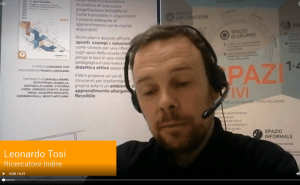Result of the work of the Indire research group on school architecture, the volume “Fare didattica in spazi flessibili. Progettare, organizzare e utilizzare gli ambienti di apprendimento a scuola” (Giunti, 2018) provides interesting insights into the relationship between pedagogy and architecture and at the same time proposes concrete solutions and examples for reorganizing school environments without structural interventions and relying on available resources. The intent is to support the reorganization of learning environments and support an idea of school well-being that recalls modern standards of comfort and habitability. The possibility of developing innovative teaching is closely linked to the definition of new environments that are more centered on the student. In fact, there are now many documents that underline how the environment interacts on the quality of learning processes, from guidelines for school construction to indications for the curriculum, up to cultural orientation documents issued by national and international organizations.
However, it is never explicit how the physical space can concretely contribute to the quality of school life and learning, what the margins of intervention should be, what the tools that can help create an effective place for teachers and students.
To respond to the need, increasingly felt by students, families and teachers, to be able to count on a space that accompanies and reinforces the educational action, the volume offers a useful set of tools to transform the classroom into a expanded and flexible learning environment. A welcoming environment in which it becomes possible to design educational paths that “come out” of the classroom and that exploit the potential offered by all the other places in the school, including unused spaces and those that are only apparently “useless”.
But the study perspective proposed by the volume is also another one, the one that starts directly from the school, through ten Learning Stories told by as many teachers who wanted to consider the physical environment as a strategic element for the quality of school life and learning. . These are examples that have the function of both touching the experience of those who have already started transforming their school spaces and triggering a reflection on possible ways of reorganizing and adapting existing spaces.
The volume was presented during the “Fiera Didacta Italia”, held in Florence on 9-10-11 October 2019. Starting from the narration of their experiences in the direction of a new conception of spaces in the school, the co-authors of the text illustrated some of the contents of the book together with Indire researchers.
Booktrailer
- Learning Story. Esploratori di Luce – Valentina Luchetti, teacher by Primo Circolo Didattico “San Filippo”, Città di Castello (PG)
- Learning Story. Geografia e storia in spazi flessibili disciplinari – Elena Marcato, teacher by IC 9 in Bologna
- Learning Story. Il viaggio di Teddy – Ambra Coccia, teacher by ISC “Solari” in Loreto (AN)
- Learning Story. Esperimenti “fuori classe” – Rodolfo Galati, primary school teacher and author of numerous books on teaching
- Learning Story. Un anno in un giorno – Matteo Bianchini, primary school teacher by Scuola-Città “Pestalozzi” in Florence
- Learning Story. Misurare il mondo a scuola – Silvia Scandura, teacher by IC “Falcone” in Copertino (LE)
- Learning Story. L’officina della curiosità – Margherita Leotta, teacher by IC “Giovanni XIII” in Acireale (CT)
- In viaggio con eTwinning – Francesca Panzica, primary school teacher
- Learning Story: Dibattendo… S’impara – Giulia Monaldi, teacher by IC “Solari” in Loreto (AN)
- Learning Story. Scienziati itineranti – Silvia Coppedè, teacher by IC “Mariti” in Fauglia (LI)
- Leonardo Tosi, Indire researcher and one of the editors of the book, interviewed by RaiScuola

Editorial staff
A series of teachers’ video-testimonials and theyr proposals for the transformation of school spaces presented in the book “Fare didattica in spazi flessibili. Progettare, organizzare e utilizzare gli ambienti di apprendimento a scuola”(Giunti, 2018)
Type: Book
Teaching in flexible spaces

